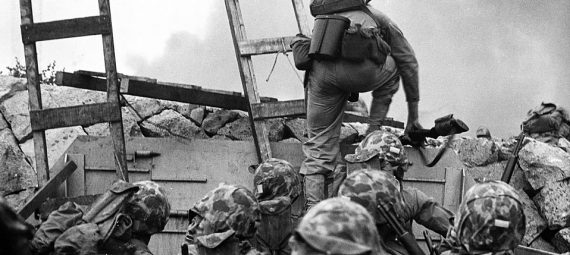
The Battle of Inchon lasted from September 15th to September 19th in 1950. It was a large-scale military operation conducted by the United Nations (UN) forces led by the United States against the North Korean’s Korean People’s Army (KPA). The UN forces successfully seized the port of Inchon, then quickly recaptured Seoul, the South Korean capital, dividing the KPA into half, forcing the KPA to retreat from South Korea.
The Battle of Inchon is one of the most important battles during the Korean War. The operation was a surprise attack on Inchon deep behind the North Korean frontline commanded by General MacArthur, achieving a strategic reversal as it forced the Korean People’s Army (KPA) to withdraw their forces. The surprise attack saved the South Korean Army (ROKA) and the US Army from being encircled by the KPA in Busan, and turned the tables by putting the KPA on the defensive. In military terms, the capture of Inchon and Seoul forced the KPA to retreat, losing large areas of conquered lands while suffering from heavy casualties and loss of heavy equipment (tanks, artillery, etc) in the process.
That capture of Inchon also had geopolitical repercussions, besides from military repercussions. For China, the defeat of KPA strengthened its determination to enter the war, as a defeated North Korea could mean US troops stationed on the Chinese border. For the United States, capturing Inchon allowed the US and South Korean Army to break out from the Pusan Perimeter, gaining an initiative on the Korean Peninsula.
Of course, the Battle of Inchon revealed the large dynamics of the early Cold War in Asia. Although deeply destructive to the Korean peninsula and devastating for those who fought it, the Korean war was ultimately limited war. It was limited both in geographic scope and in US objectives, as the aim of the US led troops was not the complete destruction and total defeat of North Korea, but rather the “limited” goal of protecting South Korea. The significance of the Korean War is that it was the first “hot” war at the beginning of the Cold War period which sets an example of limited wars during the Cold War period, from Vietnam war, the Sino-Indian War, the Falklands War, etc. Moreover, the Korea War acted as a catalyst to the Cold War confrontation, as the Truman administration was convinced that the Soviet Union was the puppet master behind North Korea, and regarded the attack as a case of Soviet, not North Korean, aggression, likely to test the determination of the West before launching a broader offensive on other territories beyond the control of the Soviet Union. Furthermore, the Korean War convinced the US government that actions must be taken against the communist world, and that any part of the world had to be protected from international Communism. which led to the approval of the United States Objectives and Programs for National Security, better known as the NSC 68, which involved significant increase in military budget, leading to massive rearmament. This marks the beginning of the US foreign policy of total containment.
The New York Times reported the event from a pro-US government standpoint. In an article published on September 18, 1950, the author Hanson Baldwin attempted to create a “us vs them” mentality to subconsciously put the readers in the shoes of the US government, convincing them that the North Korean government being on the opposing side of “them” was an example of false dichotomy. For instance, in the line “A push to the east …. bring our forces across the roads,” the US forces were identified as “our forces”, suggesting that the author was writing from a subjective perspective, which casted doubt on the reliability of the article. Such a stance could also be found in another article published on September 21, 1950, “Until last week, despite our constant bombing, the enemy is known to have operated….” implied that the readers were standing on the same side as the US troops, while the other side were identified as “the enemy.” Exaggerated positive phrases were used to describe US military actions. In the September 21 article for instance, “The great gamble …. so far has developed extremely favorably,” and, “have gone almost completely ‘according to plan.’” In contrast, when the content was associated with North Korea, the word choices were usually negative, for example, “there has been at many points fierce and desperate resistance.” Similarly, the North Korean forces were described to be “fighting furiously” in the September 18 article. These word choices showed that the author was portraying the US from a positive angle, but portraying North Korea from a negative perspective. In addition, the opponent of the US forces was commonly referred to as “the Communist armies” which created ambiguity. Such references made it hard for the readers to distinguish between the Korean People’s Army (KPA) and the People’s Volunteer Army (PVA).
Works Cited:
Baldwin, Hanson W. “‘According to Plan’: Inchon-Seoul Operation Near That Rating, but It Still Faces the Most Severe Test Shifts from the South The Russians Supplying Conscription by the North.” NEW YORK TIMES. September 21, 1950, 3
Baldwin, Hanson W. “The Landing at Inchon: Amphibious Action to Outflank the Foe In Korea Has Its Own Characteristics” NEW YORK TIMES. September 18, 1950, 4
Gamel, Kim. “’This Reversed the Korean War Virtually Overnight’: The Incheon Landing’s Victorious, Bloody Legacy 69 Years Later.” Stars and Stripes, September 10, 2019. https://www.stripes.com/news/pacific/this-reversed-the-korean-war-virtually-overnight-the-incheon-landing-s-victorious-bloody-legacy-69-years-later-1.598150.
Leffler, Melvyn P., and Odd Arne Westad, “The Korean War” in THE CAMBRIDGE HISTORY OF THE COLD WAR, eds. Vol. 1. Cambridge: Cambridge University Press, 2010, 277.

